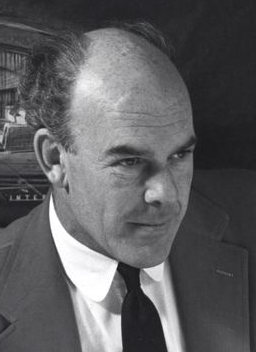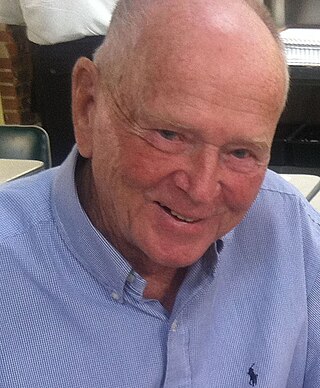
Googie architecture is a type of futurist architecture influenced by car culture, jets, the Atomic Age and the Space Age. It originated in Southern California from the Streamline Moderne architecture of the 1930s, and was popular in the United States from roughly 1945 to the early 1970s.

Westchester is a neighborhood in the City of Los Angeles and the South Bay Region of Los Angeles County, California.

The Hollywood Hotel was a famous hotel, society venue of early Hollywood, and landmark, formerly located at 6811 Hollywood Boulevard, on the north side, extending from Highland Avenue to Orchid Avenue, in central Hollywood, Los Angeles, California.

John Edward Lautner was an American architect. Following an apprenticeship in the mid-1930s with the Taliesin Fellowship led by Frank Lloyd Wright, Lautner opened his own practice in 1938, where he worked for the remainder of his career. Lautner practiced primarily in California, and the majority of his works were residential. Lautner is perhaps best remembered for his contribution to the development of the Googie style, as well as for several Atomic Age houses he designed in the late 1950s and early 1960s, which include the Leonard Malin House, Paul Sheats House, and Russ Garcia House.

The Toyota Sports Performance Center is a practice facility for the Los Angeles Kings, and the Ontario Reign, located on 555 North Nash Street in El Segundo, California. The $24 million, 135,000 square feet (12,500 m2) facility broke ground on April 28, 1999, and officially opened on March 5, 2000.

Norms Restaurants is a regional chain of diner-style restaurants in Southern California. Founded in 1949 by used-car salesman Norm Roybark, some restaurants are open 24 hours a day, 7 days a week. As of May 2024, the company operates 23 locations in Greater Los Angeles, with plans to expand into Las Vegas, Nevada.

Rancho Los Nietos was one of the first, and the largest, Spanish land concession in Alta California. Located in present-day Los Angeles County and Orange County, California. Rancho Los Nietos was awarded to Manuel Nieto in 1784. After an appeal by the San Gabriel Mission padres, Rancho Los Nietos was later reduced and Rancho Paso de Bartolo was once again a possession of the mission. The rest of the rancho remained intact until 1834, when Governor Jose Figueroa officially declared the Rancho Los Nietos grant under Mexican rule and ordered its partition into six smaller ranchos.

Founded in 1915, the Greater Los Angeles Area Council (GLAAC) (#033) served most of the City of Los Angeles as well as several other cities in the greater Los Angeles area. It was one of five Boy Scouts of America councils in Los Angeles County, California. Since its founding in 1915, the Los Angeles Area Council has brought its purpose and values to millions of youth. The Council served 54,567 youth in the Greater Los Angeles Area in 2008 alone.

Old St. Peter's Episcopal Church is a Los Angeles Historic-Cultural Monument located in the San Pedro section of Los Angeles, California, near the Port of Los Angeles. Built in 1883 in the Carpenter Gothic Victorian architecture style, it is San Pedro's oldest church.
Alan Hess is an American architect, author, lecturer and advocate for twentieth-century architectural preservation.

Pann's is a coffee shop restaurant in the Westchester neighborhood of Los Angeles, California, known for its history, role in movies, and distinctive architecture. The restaurant was opened by husband and wife George and Rena Poulos in 1958. It is also known for its neon sign, Googie architecture, and 1950s decor. The building and its iconic neon sign were designed by architects Eldon Davis and Helen Liu Fong of the Armet & Davis architectural firm. Pann's remains one of the best preserved examples of Davis' Googie designs, according to the Los Angeles Times.
Armet Davis Newlove Architects, formerly Armét & Davis, is a Californian architectural firm known for working in the Googie architecture style that marks many distinctive coffee shops and eateries in Southern California. The firm designed Pann's, the first Norms Restaurants location, the Holiday Bowl and many other iconic locations.

Wich Stand was a '50s-style coffee shop restaurant and diner in Los Angeles, California, featuring a tilting blue roof and 35-foot spire (11 m), designed by architect Eldon Davis.

Motordrome is an archaic placename in Los Angeles County, California. It designates a rail spur that existed in the 1910s on the Redondo Beach via Del Rey Line, named for the Los Angeles Motordrome race track and airfield. Motordrome station lay at an elevation of 7 feet. The coordinates for Motordrome preserved in the GNIS place it near the present-day intersections of Jefferson Boulevard and Culver Boulevard, in what is now the Ballona Wetlands Ecological Reserve.

Eldon Carlyle Davis was an American architect, considered largely responsible for the creation of Googie architecture, a form of modern architecture originating in Southern California. Googie architecture is largely influenced by Southern California's car culture and the Space Age of the mid-20th century. Davis was a founding partner of the Armet & Davis architectural firm which championed Googie architecture, including the original Norms Restaurant, a Googie coffee shop designed by Davis. For his work, the Los Angeles Times called Davis, "the father of the California coffee shop."

Corky's was a restaurant in Los Angeles, California's Sherman Oaks neighborhood. It was designed by Armet & Davis and built in 1958. It has a sweeping roofline characteristic of Googie architecture. It was remodeled in the 1970s and has been restored in recent years. It originally opened as Stanley Burke's Coffee Shop on Van Nuys Boulevard and became Corky's in the early 1960s as it transitioned to being open 24-7. Billy Joel played piano at the eatery in the 1970s. After 25 years as Corky's, it became the Lamplighter, and was used in 2010 as a filming location for A Nightmare on Elm Street. The restaurant is now restored and renovated as a renewed Corky's.
Harry Harrison was an architect in Los Angeles, California.
Googie's Coffee Shop was a small restaurant located at 8100 Sunset Boulevard in Los Angeles next door to the famous Schwab's Pharmacy at the beginning of the Sunset Strip. It was designed in 1949 by architect John Lautner and lent its name to Googie architecture, a genre of modernist design in the 1950s and 60s. Interest in the style was revived by the 1986 book Googie: Fifties Coffee Shop Architecture by Alan Hess.














